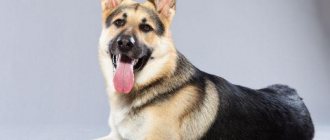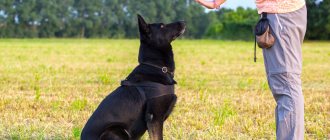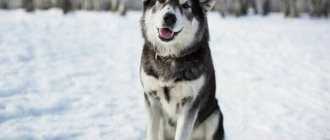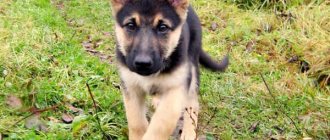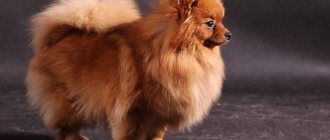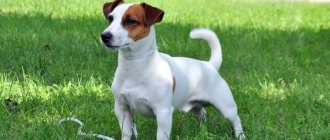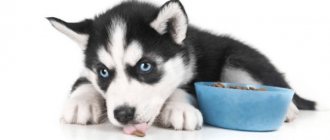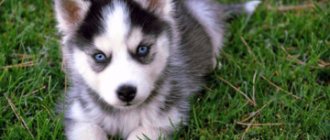Features of the breed - character and temperament
Huskies are loyal dogs with blue eyes. Often it is this unusual sign that makes you want to have a four-legged friend. But the color of the iris is not the most memorable feature of this breed.
Interesting article: Characteristics of the Siberian Husky: education and training
Although the husky's direct ancestor is the wolf, they are affectionate and friendly dogs. They are stubborn and willful, they need an owner with leadership qualities who will tame an independent pet.
This is interesting: What happens if you cross a husky with a shepherd
Representatives of the Husky breed have innate sled dog abilities, and their activity often exceeds all expectations. Lazy and irresponsible people are not recommended to have such a pet. If Husky training is not supervised, this can result in uncontrollable or dangerous behavior in the dog.
Expert opinion
Anna Abramenko
An avid dog lover. Experience in veterinary medicine since 2009.
Ask a Question
Huskies adapt well to apartments if they are given regular long walks. They become strongly attached to the family with whom they live, but internally they choose one master and unquestioningly obey only him. The dogs are clean, do not make a mess, and get along well with children.
Huskies are good with dogs of other breeds and calmly spend time with them in the same room. But there may be problems living together with animals of other species - cats, domestic rodents, parrots. Due to its strong hunting instinct, a dog can at least injure another pet.
Interesting article: 5 ways to make friends between a cat and a dog in an apartment
How hard is it to train?
Difficulties in training arise with any dog, the husky is no exception. Representatives of the breed, as written above, are stubborn, they require increased attention when practicing commands. The owner, when training a dog, has no right to make a mistake, because it is impossible to correct it on his own without experience in behavior correction.
The Husky is a working dog and requires a completely different approach to training than a working dog. Husky training begins at three months of age; until then, the puppy is raised without the use of physical force or raising his voice.
Golden rules that must be followed by the owner:
- Husky puppies make you want to show tenderness, pet them once again, hug and cuddle, lisping at the same time. The pet should receive affection in portions, as a reward. Hugs and lamentations will let the puppy understand that the owner is weak-willed; he can sit on his neck and not obey.
- Consistency in education and training is key. A ban on something must be permanent, as well as permission for a particular action. For example, a puppy wants to climb onto the sofa, but the owner forbids it. The next day, the pet again tries to climb onto the sofa, the owner smiles and allows it. This should not happen, because the puppy will refuse to understand the inconsistent owner in the future.
- Huskies require respectful treatment. Yelling at a small pet is prohibited, as is yelling at an adult dog.
- Representatives of the breed are smart, but very independent and are able to make decisions without regard to the owner’s opinion. You should not allow your dog to think about whether to follow the command or not. Commands are carried out without fail, without any hesitation. Read about the smartest dog breeds.
- Training begins with play; huskies cannot stand routine; activities should arouse their interest. An assistant in this matter will be a toy that motivates the dog.
Important training rules
Expert opinion
Anna Abramenko
An avid dog lover. Experience in veterinary medicine since 2009.
Ask a Question
The main mistake of a husky owner is usually permissiveness. If you do not react to the puppy’s misdeeds, he will soon begin to consider himself the main member of the family. This should not be allowed, because then raising and training huskies will be much more difficult.
Physical violence for disobedience is unacceptable. Huskies are difficult to train, but love encouragement and praise. It is important to be consistent in the learning process. If the execution of any command causes difficulties, then the problem is the pet’s simple lack of interest in the action. Then it is necessary to change the technique or reconsider how you treat the animal.
Useful article: What to feed a husky: rating of dry food for a husky puppy, diet at home
It is worth noting several husky habits that can cause discomfort to the owner and people around him:
- Digging is a favorite pastime of representatives of this breed. Dogs don’t care at all where and what to dig - they care about the process, not the result. Unfortunately, urban apartment conditions will not prevent you from getting rid of a strange feature - huskies can easily open the floor or lift the linoleum. In this case, it is useless to scold and punish your pet; it is better to enroll it in special classes with a dog handler or walk the animal more often, loading it with physical activity.
- Vagrancy - the habit of running away, combined with curiosity and sociability, can turn into an unpleasant incident. You should never let a husky go without a leash in the city - this is illegal and dangerous for her. When walking in nature, you need to carefully monitor your pet.
- Excessive stubbornness - Huskies demonstrate their character and independence in every possible way; they do not take orders. The owner needs to be patient and pay a lot of attention to his four-legged friend, so that he feels an older mentor in the person and learns to obey him.
It is worth noting several husky habits that can cause discomfort to the owner and people around him:
- Digging is a favorite pastime of representatives of this breed. Dogs don’t care at all where and what to dig - they care about the process, not the result. Unfortunately, urban apartment conditions will not prevent you from getting rid of a strange feature - huskies can easily open the floor or lift the linoleum. In this case, it is useless to scold and punish your pet; it is better to enroll it in special classes with a dog handler or walk the animal more often, loading it with physical activity.
- Vagrancy - the habit of running away, combined with curiosity and sociability, can turn into an unpleasant incident. You should never let a husky go without a leash in the city - this is illegal and dangerous for her. When walking in nature, you need to carefully monitor your pet.
- Excessive stubbornness - Huskies demonstrate their character and independence in every possible way; they do not take orders. The owner needs to be patient and pay a lot of attention to his four-legged friend, so that he feels an older mentor in the person and learns to obey him.
Huskies quickly get bored with constantly repeated commands, and you will have to try to interest the dog.
Training huskies at home and in the wild will be successful if they are trained as a puppy, and not as a grown dog, which is much more difficult to retrain.
Huskies quickly get bored with constantly repeated commands, and you will have to try to interest the dog.
The puppy is taught to follow this command from the moment it arrives in the house. To do this, you need to define a personal space for him in advance. When you see that a small husky is sleeping or lying outside of its territory, you need to carefully move it to a rug or bedding, gently pat it on it and confidently say: “Place.” After 1-2 weeks, the pet will learn to return to its designated home area on command.
Transition to basic training
When the husky puppy is three to four months old, the best decision would be to sign up with him for group classes in UGS (“Manageable City Dog”) or OKD (general training course). Such classes are conducted by a canine instructor; the group usually trains about ten dogs of the same training level. Of course, the puppy will study first in the most inexperienced group, gradually increasing the levels of training.
Important point! There is no need to try to teach a husky puppy commands on your own if this is your first time with a dog of this breed. Mistakes made will take much longer to correct, and it is easier to immediately practice under the supervision of an experienced zoo specialist than to then correct the dog’s behavior.
What is included in the OKD of dogs?
It’s good if the instructor you choose has experience working with huskies and knows the peculiarities of their temperament and psychology. But, in general, training a Husky is no different from training any other breed. Perhaps the owner will have to put in a little more work, show patience and tact towards his pet, and also work tirelessly to repeat and “polish” the learned commands.
With due diligence, the owner of the husky will be able to successfully complete a basic obedience course! The main thing is to properly motivate the dog, reward successes in a timely manner, and also work out the moments that don’t work out. Let's take a closer look at how to praise and punish a dog during the training process.
Video - Husky passes the OKD exam
Command training
The puppy is taught to follow this command from the moment it arrives in the house. To do this, you need to define a personal space for him in advance. When you see that a small husky is sleeping or lying outside of its territory, you need to carefully move it to a rug or bedding, gently pat it on it and confidently say: “Place.” After 1-2 weeks, the pet will learn to return to its designated home area on command.
"Place"
This is a basic and very important command for a dog. You can teach it almost without difficulty and from scratch, when the puppy has recently mastered the new home and got used to the owner. If a baby husky picks up an unfamiliar object on the street, you should immediately take the thing out of his mouth and clearly say: “No.” If such actions are repeated by the dog, you should lightly press it to the ground or scold it for being stubborn, but under no circumstances should you shout or use physical force.
"It is forbidden"
Other breeds learn this command quickly and without difficulty, but for active huskies it is not easy to perform. To accustom your dog to this action, you need to hold the dog to your left, not give him the opportunity to run forward, and constantly repeat: “Nearby.” If successful, be sure to reward your pet with praise or something tasty. It will take time and patience to consolidate the skill.
"Near"
Other breeds learn this command quickly and without difficulty, but for active huskies it is not easy to perform. To accustom your dog to this action, you need to hold the dog to your left, not give him the opportunity to run forward, and constantly repeat: “Nearby.” If successful, be sure to reward your pet with praise or something tasty. It will take time and patience to consolidate the skill.
"To me"
This team needs to be trained as follows. The owner calls the baby husky to his place and shows him food. Then he raises his hand so that the pet can only see the treat while sitting. When the dog sits down, the person clearly calls the command and gives him a treat.
"Sit"
The Husky is a non-working dog, so this type of training can be challenging. To teach her the “Voice!” command, you need to use a short leash and sweets. The owner, holding a treat in front of the dog, raises his hand up and says the command several times when the dog begins to bark or whine in attempts to get the treat. But huskies have an interesting feature. Dogs of this breed trained to vocalize do not bark, but howl, but this is also considered a positive result.
"Voice"
In parallel with other commands, you can practice the simple technique “lie down” - it is especially successfully combined with “sit”. But it will not be possible to train a husky to the “face” skill, because this dog is not a guard dog, but a sled breed, and one should not demand the impossible from it.
In parallel with other commands, you can practice the simple technique “lie down” - it is especially successfully combined with “sit”. But it will not be possible to train a husky to the “face” skill, because this dog is not a guard dog, but a sled breed, and one should not demand the impossible from it.
Huskies have an independent and dominant character, so training is based on alternating methods of praise and punishment. Positive reinforcement is considered the most effective technique. It consists of using small pieces of the dog’s favorite food – meat, fish, dry food – during the training process. Portions should be small so that the pet does not get full, but only gets a taste of the food.
How to care for a husky
It is better to keep active, restless huskies in a private house with a plot or enclosure. They adapt to the apartment provided they are walked daily 2 times a day, for at least 1.5-2 hours. Outdoor games, overcoming obstacles, and hiking in unfamiliar places will be beneficial. The dog will get the necessary physical activity, burn off energy, and at home he will be calm and well-mannered.
The breed is very clean. The main thing is grooming. Self-cleaning coat must be brushed regularly, and brushed every day during the shedding period. It is enough to bathe 1-2 times a year. Carefully inspect the coat, skin, paws, ears after each walk, teaching hygiene procedures from childhood.
A puppy of 1.5-2 months is fed 5-6 times a day, gradually reducing the number of meals. At the age of 7 months you can switch to two meals a day, at 12 months - to an adult feeding regimen. ¾ of the diet is natural meat and fish. Last meal at 21-22 hours. Place food at the same time every day. Compliance with the regime has a positive effect on proper digestion and normal bowel movements of the husky.
With proper maintenance and care, huskies almost never get sick and live on average up to 14 years.
Punishment and reward
Huskies have an independent and dominant character, so training is based on alternating methods of praise and punishment. Positive reinforcement is considered the most effective technique. It consists of using small pieces of the dog’s favorite food – meat, fish, dry food – during the training process. Portions should be small so that the pet does not get full, but only gets a taste of the food.
To teach representatives of this breed the necessary skills, patience and perseverance are needed. The owner's voice and intonation play a huge role in training. Commands must be pronounced clearly, confidently, but without irritation or aggression. We must not forget that the husky often responds to requests, but ignores orders.
If you can’t raise an obedient four-legged friend on your own, it is recommended to contact an experienced dog handler who will help you train a husky in practice.
Basics of education
Experienced breeders note the fearlessness of huskies, so methods of threatening and beating have little effect on the animal.
At the same time, it has been noticed that huskies love to play monkeys. The dog adopts many habits and habits of its enclosure neighbors or other members of the pack.
It is better to protect huskies from borrowing the qualities of service dogs - the dog, as a rule, only imitates behavior that is unusual for it.
However, training based on the imitation and reward method is considered basic for huskies.
At the same time, methods of punishment remain relevant. It is not so much painful techniques that help to train a dog, but rather subduing ones.
These include:
- even stern voice;
- confident behavior;
- inflexibility, consistency in achieving the goal.
It was these methods that brought success to the huskies themselves - the dogs used them in their nomadic life.
The Siberian domesticated wolf is not stubborn - he is persistent in achieving what he wants. But the dog is able to submit to someone else’s force when it understands which side has the advantage.
To demonstrate your own will, you can increase the complexity and intensity of training with your dog: make it run until exhaustion or force it to overcome fear.
For example, training on stairs with performing exercises at height will help.
A more radical way to subjugate a husky is to restrict freedom of movement.
For example: using a palm grip on the dog’s withers, with a strong movement you need to press his head to the ground and hold it until the resistance stops.
Often an effective method, used in extreme cases, is a tether or a closed, cramped enclosure.
At the same time, you need to make sure that the husky does not outwit the trainer: the educational measure should not end with the triumphant victory march of the dog, who has broken the leash or undermined the fence.
Video
Raising an animal should be based on once-established rules. You cannot change the commands to which the dog is taught; you need to achieve their precise implementation in any conditions. Husky training will be more successful if it is accompanied by a walk and active games.
Raising an animal should be based on once-established rules. You cannot change the commands to which the dog is taught; you need to achieve their precise implementation in any conditions. Husky training will be more successful if it is accompanied by a walk and active games.
When to start
New owners have a natural question: at what age should they start raising a husky puppy? Most often, the start of training for teams is 2.5–3 months. Some owners begin training at 2 months. It all depends on the individual characteristics of the dog.
For a husky puppy, 2 months is the age when you can already “introduce” him to a collar.
Vaccinations
Two-month-old puppies are first vaccinated against common diseases with complex vaccinations only after deworming.
Ten days before vaccination, the puppy is given anti-worm medication, then vaccinated at three-week intervals.
The quarantine ends two weeks after the second vaccination, and only then can you start walking your pet.
Some veterinarians recommend another vaccination up to a year, in the period after changing teeth.
Important! It is very important in spring and summer to protect huskies from tick bites , since ticks are carriers of piroplasmosis.
Little “Eskimos” - they definitely won’t let their owners get bored
This disease is fatal without treatment, and the animal often dies in a matter of days.
Drops on the withers, anti-tick collars and sprays - these products can be combined for the best protection.
